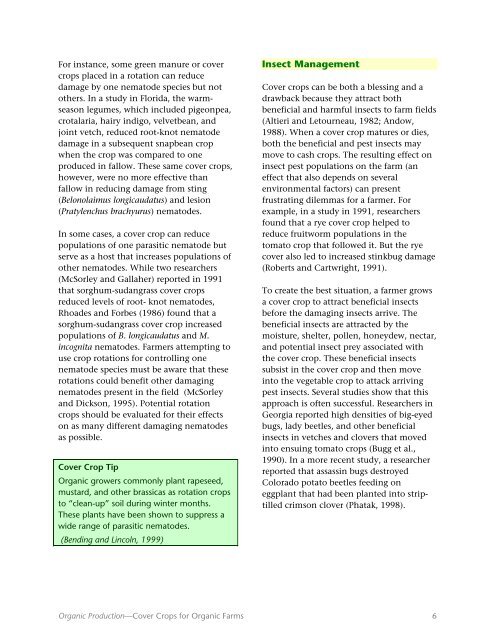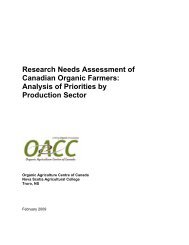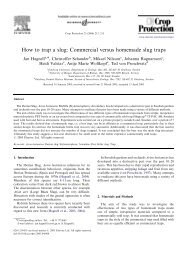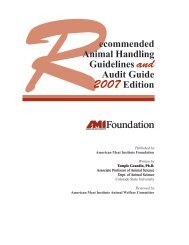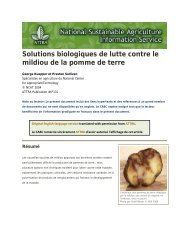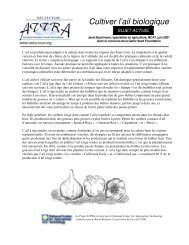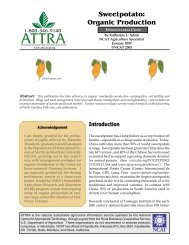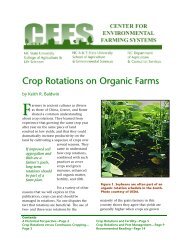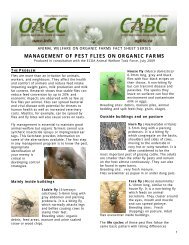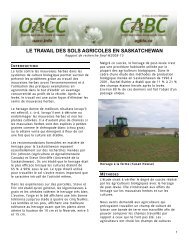For instance, some green manure or covercrops placed in a rotation can reducedamage by one nematode species but notothers. In a study in Florida, the warmseasonlegumes, which included pigeonpea,crotalaria, hairy indigo, velvetbean, andjoint vetch, reduced root-knot nematodedamage in a subsequent snapbean cropwhen the crop was compared to oneproduced in fallow. These same cover crops,however, were no more effective thanfallow in reducing damage from sting(Belonolaimus longicaudatus) and lesion(Pratylenchus brachyurus) nematodes.In some cases, a cover crop can reducepopulations of one parasitic nematode butserve as a host that increases populations ofother nematodes. While two researchers(McSorley and Gallaher) reported in 1991that sorghum-sudangrass cover cropsreduced levels of root- knot nematodes,Rhoades and Forbes (1986) found that asorghum-sudangrass cover crop increasedpopulations of B. longicaudatus and M.incognita nematodes. Farmers attempting touse crop rotations <strong>for</strong> controlling onenematode species must be aware that theserotations could benefit other damagingnematodes present in the field (McSorleyand Dickson, 1995). Potential rotationcrops should be evaluated <strong>for</strong> their effectson as many different damaging nematodesas possible.<strong>Cover</strong> Crop Tip<strong>Organic</strong> growers commonly plant rapeseed,mustard, and other brassicas as rotation cropsto “clean-up” soil during winter months.These plants have been shown to suppress awide range of parasitic nematodes.(Bending and Lincoln, 1999)Insect Management<strong>Cover</strong> crops can be both a blessing and adrawback because they attract bothbeneficial and harmful insects to farm fields(Altieri and Letourneau, 1982; Andow,1988). When a cover crop matures or dies,both the beneficial and pest insects maymove to cash crops. The resulting effect oninsect pest populations on the farm (aneffect that also depends on severalenvironmental factors) can presentfrustrating dilemmas <strong>for</strong> a farmer. Forexample, in a study in 1991, researchersfound that a rye cover crop helped toreduce fruitworm populations in thetomato crop that followed it. But the ryecover also led to increased stinkbug damage(Roberts and Cartwright, 1991).To create the best situation, a farmer growsa cover crop to attract beneficial insectsbe<strong>for</strong>e the damaging insects arrive. Thebeneficial insects are attracted by themoisture, shelter, pollen, honeydew, nectar,and potential insect prey associated withthe cover crop. These beneficial insectssubsist in the cover crop and then moveinto the vegetable crop to attack arrivingpest insects. Several studies show that thisapproach is often successful. Researchers inGeorgia reported high densities of big-eyedbugs, lady beetles, and other beneficialinsects in vetches and clovers that movedinto ensuing tomato crops (Bugg et al.,1990). In a more recent study, a researcherreported that assassin bugs destroyedColorado potato beetles feeding oneggplant that had been planted into striptilledcrimson clover (Phatak, 1998).<strong>Organic</strong> Production—<strong>Cover</strong> <strong>Crops</strong> <strong>for</strong> <strong>Organic</strong> <strong>Farms</strong> 6
Nitrogen FixationOne of the most significant contributionsthat legume cover crops make to the soil isthe nitrogen (N) they contain. Legumecover crops fix atmospheric N in their planttissues in a symbiotic or mutually beneficialrelationship with rhizobium bacteria. Inassociation with legume roots, the bacteriaconvert atmospheric N into a <strong>for</strong>m thatplants can use. As cover crop biomassdecomposes, these nutrients are released <strong>for</strong>use by cash crops. Farmers should make anef<strong>for</strong>t to understand this complex processbecause it will help them to select theproper legumes <strong>for</strong> their cropping plan,calculate when to incorporate cover cropsand plant cash crops that follow, and planfertilizer rates and schedules <strong>for</strong> those cashcrops. Above all, they need to inoculatelegume seed be<strong>for</strong>e planting with theappropriate Rhizobium species.<strong>Cover</strong> Crop TipNonleguminous cover crops, typically grassesor small grains, do not fix nitrogen. Nonetheless,they can be effective in recovering mineralizednitrogen from soil after crops areharvested.The N associated with cover crop biomassundergoes many processes be<strong>for</strong>e it is readyto be taken up <strong>for</strong> use by cash crops. Theprocess begins with biomass N, which is thenitrogen contained in mature cover crops.From 75 to 90 percent of the nitrogencontent in legume cover crops is containedin the aboveground portions of the plant,with the remaining N in its roots andnodules (Shipley et al., 1992).When legume or grass cover crops are killedand incorporated into the soil, livingmicroorganisms in the soil go to work todecompose plant residues. The biomassnitrogen is mineralized and converted firstto ammonium (NH 4) and then to nitratecompounds (NO 3) that plant roots can takeup and use. The rate of this mineralizationprocess depends largely on the chemicalcomposition of the plant residues that areinvolved (Clement et al., 1995), and onclimatic conditions.Determining the ratio of carbon to nitrogen(C:N) in the cover crop biomass is the mostcommon way to estimate how quicklybiomass N will be mineralized and released<strong>for</strong> use by cash crops. As a general rule,cover crop residues with C:N ratios lowerthan 25:1 will release N quickly. In thesoutheastern U. S., legume cover crops,such as hairy vetch and crimson clover,killed immediately be<strong>for</strong>e corn plantinggenerally have C:N ratios of 10:1 to 20:1(Ranells and Wagger, 1997). Residues withC:N ratios greater than 25:1, such as cerealrye and wheat, decompose more slowly andtheir N is more slowly released.A study conducted in 1989 reported that 75to 80 percent of the biomass N produced byhairy vetch and crimson clover residues wasreleased eight weeks after the cover cropswere incorporated into the soil (Wagger,1989a). This amounted to 71 to 85 poundsof N per acre. However, not all of thereleased N was taken up by the subsequentcorn crop. The corn utilized approximately50 percent of the N released by bothresidues. (This value may be con-sidered theN uptake efficiency of corn from legumeresidues. This value is similar to the Nuptake efficiency of corn from inorganicfertilizer sources, such as ammoniumnitrate.) The N not taken up by the followingcrops may still contribute to soil health.Living microbes in the soil may use thenitrogen to support population growth andmicrobial activity in the soil.<strong>Organic</strong> Production—<strong>Cover</strong> <strong>Crops</strong> <strong>for</strong> <strong>Organic</strong> <strong>Farms</strong> 7


